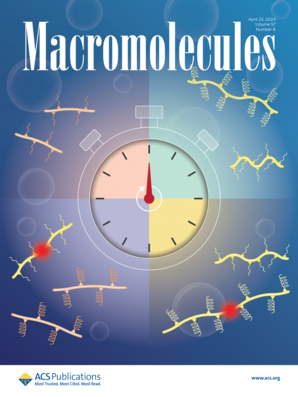基于柱芳烃的超分子聚合物凝胶的时变信息加密
IF 5.2
1区 化学
Q1 POLYMER SCIENCE
引用次数: 0
摘要
随着信息技术的飞速发展,信息安全已成为全球关注的热点问题。为了保护信息安全,人们在开发智能材料方面做了很多努力。基于超分子聚合物凝胶(SPG)材料的时变信息加密具有固有的刺激响应性、良好的可加工性和优异的自愈性等优点。在此,我们报告了一种基于柱芳烃的具有可调谐荧光发射的SPG构建的时变信息加密材料。制备了一种含联吡啶衍生物的荧光聚合物P1和一种含柱芳烃的聚合物P2。P1在加入酸后,由于其联吡啶基团质子化,荧光发射从蓝色红移到蓝绿色。P1的质子化形式记为P1H。当P1H与P2混合时,形成SPG,同时由于柱芳烃与质子化联吡啶衍生物客体之间的主客体相互作用导致蓝绿色荧光猝灭。有趣的是,调整添加到SPG中的酸的浓度可以控制荧光颜色变化的速率,从而实现在不同时间尺度上变化的动态信息加密。由于该超分子体系在外界刺激下具有可逆性,解密后的信息可以通过碱基处理或等待一段时间不做任何处理的方式进行再次加密,避免了存储信息的泄露,提升了信息的安全性。本文章由计算机程序翻译,如有差异,请以英文原文为准。

Time-Dependent Information Encryption Using a Supramolecular Polymer Gel Based on a Pillararene
With the rapid development of information technology, information security has become a hot topic of global concern. Many efforts have been devoted to developing intelligent materials for safeguarding information. Time-dependent information encryption based on supramolecular polymer gel (SPG) materials has many advantages including intrinsic stimuli responsiveness, good processability, excellent self-healing property, and so on. Herein, we report a time-dependent information encryption material constructed by a SPG with tunable fluorescence emission based on a pillararene. A bipyridine derivative-containing fluorescent polymer P1 and a pillararene-containing polymer P2 were prepared. P1 underwent a fluorescence emission decrease with a red shift from blue to blue-green after adding the acid due to the protonation of its bipyridine group. The protonated form of P1 was denoted as P1H. When P1H was mixed with P2, a SPG formed, accompanied by quenching of the blue-green fluorescence due to the host–guest interactions between a pillararene and the protonated bipyridine derivative guest. Intriguingly, adjusting the concentration of the acid added to the SPG can control the rate of fluorescence color change, enabling dynamic information encryption that can vary over different time scales. Due to the reversible property of this supramolecular system under external stimuli, the decrypted information could be encrypted again by treating with base or waiting for a period of time without any treatment, avoiding the leakage of the stored information and upgrading the information security.
求助全文
通过发布文献求助,成功后即可免费获取论文全文。
去求助
来源期刊

Macromolecules
工程技术-高分子科学
CiteScore
9.30
自引率
16.40%
发文量
942
审稿时长
2 months
期刊介绍:
Macromolecules publishes original, fundamental, and impactful research on all aspects of polymer science. Topics of interest include synthesis (e.g., controlled polymerizations, polymerization catalysis, post polymerization modification, new monomer structures and polymer architectures, and polymerization mechanisms/kinetics analysis); phase behavior, thermodynamics, dynamic, and ordering/disordering phenomena (e.g., self-assembly, gelation, crystallization, solution/melt/solid-state characteristics); structure and properties (e.g., mechanical and rheological properties, surface/interfacial characteristics, electronic and transport properties); new state of the art characterization (e.g., spectroscopy, scattering, microscopy, rheology), simulation (e.g., Monte Carlo, molecular dynamics, multi-scale/coarse-grained modeling), and theoretical methods. Renewable/sustainable polymers, polymer networks, responsive polymers, electro-, magneto- and opto-active macromolecules, inorganic polymers, charge-transporting polymers (ion-containing, semiconducting, and conducting), nanostructured polymers, and polymer composites are also of interest. Typical papers published in Macromolecules showcase important and innovative concepts, experimental methods/observations, and theoretical/computational approaches that demonstrate a fundamental advance in the understanding of polymers.
 求助内容:
求助内容: 应助结果提醒方式:
应助结果提醒方式:


